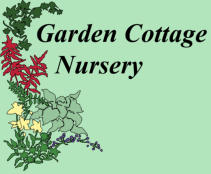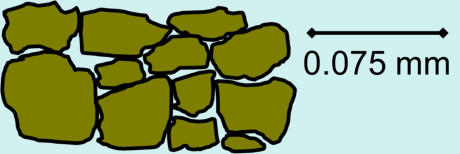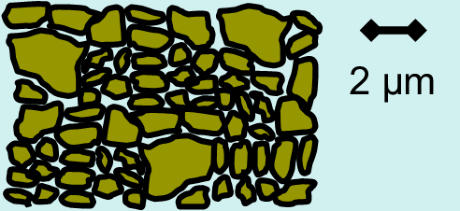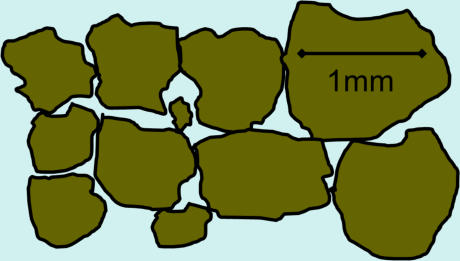
© Garden Cottage Nursery, 2022

Soil Make Up
Making A Border

Soils come in numerous flavours. A gardener should know the approximate pH of their soil, the texture and relative fertility of their
soil.
Soil is made ground up rocks and it’s fertility is determined by the chemical composition of the rock from which it was made and by
the size of the particles it comprises. The smaller the surface area to volume ratio of particles the more reactive surface is available
and so, all other things being equal, the more fertile the soil will be.
The texture of a soil are classified in three broad categories; sandy, silt and clay and as combinations of these three. The
categories are separated by the size range of the particles that it comprises.
Sandy
Sandy soils are those made of mostly the largest particles in the range of 0.063 mm to 2mm. As a sandy soil is made of large
particles there are larger gaps between the particles and they are not as tightly packed as with finer grained soils, this means water
can drain quickly down through it.
A free draining soil is useful in the winter, not so much in the summer. Adding organic material like garden compost or manure,
which act as sponges, will aid moisture retention.
Sandy soil is the lightest and easiest to work but the least inherently fertile.

Silt
Clay
Silt soils are those made of mostly particles in the range of 0.063 mm to 2μm (0.002 mm). The fine particle size raises in fertility and
makes for a more tightly packed structure, impeding drainage.
Clay soils are made of the smallest particles of less than 2μm (0.002 mm). Their extreme fineness allows them to settle into a very
compact state (suitable for moulding when wet and firing into pots) that water finds it difficult to penetrate. The fertility is very high
due to the high surface area to volume ratio.
A clay-rich soil will be cloddy and very difficult to work. Gardeners will want to add sand and/or organic matter to open it up and
improve drainage.

Loam
A loam is a sort of soil that is the Goldilocks mixture of the three particle sizes above; about 2:2:1 sand, silt and clay.
A soil described as a ‘sandy loam’ would be heavier on the sand in the ratio. A ‘heavy loam’ would have more clay in the mix.

Peat
Peat is organic material, i.e. plant roots, leaves and shoots that never fully rotted away, basically because of being too wet, cold and
starved of oxygen. The more evenly graded, spongier peats are made mostly from sphagnum moss.
As peat is made of rotten plants rather than ground rock it is not technically soil.
If your garden is peat then you will need to import top soil to be able to make a respectable herbaceous border.
Chalk
We are a nursery in the Northwest Highlands of Scotland, over 600 miles from the White Cliffs of Dover, perhaps you should look
for more local expertise ;-).











© Garden Cottage Nursery, 2021

Soil Make Up
Making A Border

Soils come in numerous flavours. A gardener should know the
approximate pH of their soil, the texture and relative fertility of
their soil.
Soil is made ground up rocks and it’s fertility is determined by
the chemical composition of the rock from which it was made
and by the size of the particles it comprises. The smaller the
surface area to volume ratio of particles the more reactive
surface is available and so, all other things being equal, the
more fertile the soil will be.
The texture of a soil are classified in three broad categories;
sandy, silt and clay and as combinations of these three. The
categories are separated by the size range of the particles that
it comprises.
Sandy
Sandy soils are those made of mostly the largest particles in the
range of 0.063 mm to 2mm. As a sandy soil is made of large
particles there are larger gaps between the particles and they
are not as tightly packed as with finer grained soils, this means
water can drain quickly down through it.
A free draining soil is useful in the winter, not so much in the
summer. Adding organic material like garden compost or
manure, which act as sponges, will aid moisture retention.
Sandy soil is the lightest and easiest to work but the least
inherently fertile.

Silt
Clay
Silt soils are those made of mostly particles in the range of
0.063 mm to 2μm (0.002 mm). The fine particle size raises in
fertility and makes for a more tightly packed structure, impeding
drainage.
Clay soils are made of the smallest particles of less than 2μm
(0.002 mm). Their extreme fineness allows them to settle into a
very compact state (suitable for moulding when wet and firing
into pots) that water finds it difficult to penetrate. The fertility is
very high due to the high surface area to volume ratio.
A clay-rich soil will be cloddy and very difficult to work.
Gardeners will want to add sand and/or organic matter to open
it up and improve drainage.

Loam
A loam is a sort of soil that is the Goldilocks mixture of the three
particle sizes above; about 2:2:1 sand, silt and clay.
A soil described as a ‘sandy loam’ would be heavier on the sand
in the ratio. A ‘heavy loam’ would have more clay in the mix.

Peat
Peat is organic material, i.e. plant roots, leaves and shoots that
never fully rotted away, basically because of being too wet, cold
and starved of oxygen. The more evenly graded, spongier peats
are made mostly from sphagnum moss.
As peat is made of rotten plants rather than ground rock it is not
technically soil.
If your garden is peat then you will need to import top soil to be
able to make a respectable herbaceous border.
Chalk
We are a nursery in the Northwest Highlands of Scotland, over
600 miles from the White Cliffs of Dover, perhaps you should
look for more local expertise ;-).

























